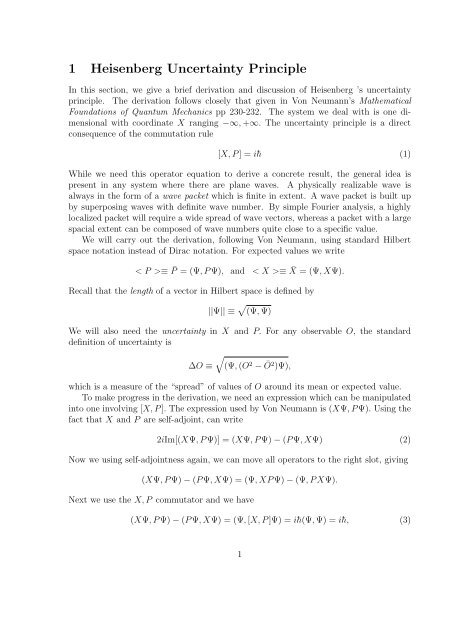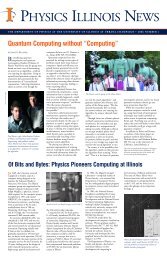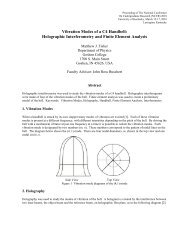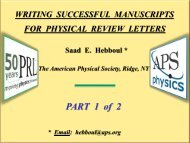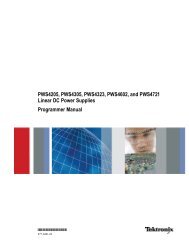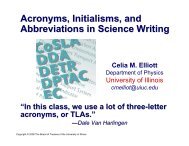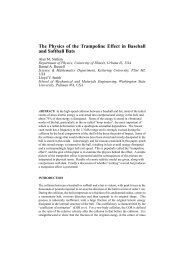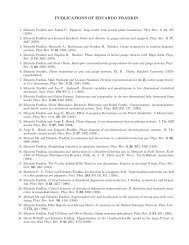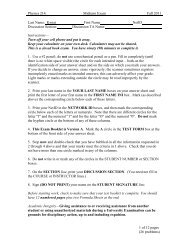1 Heisenberg Uncertainty Principle
1 Heisenberg Uncertainty Principle
1 Heisenberg Uncertainty Principle
You also want an ePaper? Increase the reach of your titles
YUMPU automatically turns print PDFs into web optimized ePapers that Google loves.
1 <strong>Heisenberg</strong> <strong>Uncertainty</strong> <strong>Principle</strong><br />
In this section, we give a brief derivation and discussion of <strong>Heisenberg</strong> ’s uncertainty<br />
principle. The derivation follows closely that given in Von Neumann’s Mathematical<br />
Foundations of Quantum Mechanics pp 230-232. The system we deal with is one dimensional<br />
with coordinate X ranging −∞, +∞. The uncertainty principle is a direct<br />
consequence of the commutation rule<br />
[X, P ] = i¯h (1)<br />
While we need this operator equation to derive a concrete result, the general idea is<br />
present in any system where there are plane waves. A physically realizable wave is<br />
always in the form of a wave packet which is finite in extent. A wave packet is built up<br />
by superposing waves with definite wave number. By simple Fourier analysis, a highly<br />
localized packet will require a wide spread of wave vectors, whereas a packet with a large<br />
spacial extent can be composed of wave numbers quite close to a specific value.<br />
We will carry out the derivation, following Von Neumann, using standard Hilbert<br />
space notation instead of Dirac notation. For expected values we write<br />
< P >≡ ¯P = (Ψ, P Ψ), and < X >≡ ¯X = (Ψ, XΨ).<br />
Recall that the length of a vector in Hilbert space is defined by<br />
||Ψ|| ≡ √ (Ψ, Ψ)<br />
We will also need the uncertainty in X and P. For any observable O, the standard<br />
definition of uncertainty is<br />
√<br />
∆O ≡ (Ψ, (O 2 − Ō2 )Ψ),<br />
which is a measure of the “spread” of values of O around its mean or expected value.<br />
To make progress in the derivation, we need an expression which can be manipulated<br />
into one involving [X, P ]. The expression used by Von Neumann is (XΨ, P Ψ). Using the<br />
fact that X and P are self-adjoint, can write<br />
2iIm[(XΨ, P Ψ)] = (XΨ, P Ψ) − (P Ψ, XΨ) (2)<br />
Now we using self-adjointness again, we can move all operators to the right slot, giving<br />
(XΨ, P Ψ) − (P Ψ, XΨ) = (Ψ, XP Ψ) − (Ψ, P XΨ).<br />
Next we use the X, P commutator and we have<br />
(XΨ, P Ψ) − (P Ψ, XΨ) = (Ψ, [X, P ]Ψ) = i¯h(Ψ, Ψ) = i¯h, (3)<br />
1
where in the last equality we have assumed a normalizable state with (Ψ, Ψ) = 1. Comparing<br />
Eqs.(2) and (3) we now have<br />
Im[(XΨ, P Ψ)] = ¯h 2<br />
(4)<br />
So far we have made no approximations. Eq.(4) is exact. To get the uncertainty relation,<br />
we now make use of some inequalities. First we make use of the fact that the imaginary<br />
part of a complex number is less than the absolute value of the complex number. For us<br />
this says<br />
Im[(XΨ, P Ψ)] ≤ |(XΨ, P Ψ)|,<br />
which implies using Eq.(4) that<br />
|(XΨ, P Ψ)| ≥ ¯h 2<br />
(5)<br />
We now have an inequality involving X and P which came directly from the commutator<br />
Eq.(1), but it involves X and P in the same matrix element. To separate them, we now<br />
use the Schwarz inequality, which states<br />
|(Ψ, Φ)| ≤ ||Ψ|| · ||Φ||,<br />
which is the Hilbert space version of the familiar statement that the dot product of two<br />
vectors is ≤ the product of their lengths. For us, the vectors we will apply the Schwarz<br />
inequality to are XΨ, and P Ψ. We have<br />
|(XΨ, P Ψ)| ≤ ||XΨ|| · ||P Ψ||,<br />
so we now have<br />
||XΨ|| · ||P Ψ|| ≥ ¯h 2<br />
(6)<br />
This is almost what we want, but makes no reference to the expected values ¯X and ¯P ,<br />
both of which come into their respective uncertainties. To remedy this we define<br />
X ′ = X − ¯XI, P ′ = P − ¯P I.<br />
These operators satisfy the basic commutation rule,<br />
[X ′ , P ′ ] = i¯h.<br />
All the steps in our derivation hold if we replace X by X ′ , and P by P ′ , This allows us<br />
to write<br />
||X ′ Ψ|| · ||P ′ Ψ|| ≥ ¯h 2 . (7)<br />
This really is the uncertainty principle. To see this, we write<br />
||X ′ Ψ|| 2 = (X ′ Ψ, X ′ Ψ) = (Ψ, X ′ X ′ Ψ) = (Ψ, (X 2 − 2X ¯X + ¯X 2 )Ψ)<br />
2
= (Ψ, (X 2 − ¯X 2 )Ψ) = (∆X) 2 ,<br />
and likewise for ||P ′ Ψ|| 2 . Using these results we finally have<br />
∆X · ∆P ≥ ¯h 2<br />
This completes the mathematical derivation of the uncertainty principle. There is a very<br />
nice physical discussion of it in <strong>Heisenberg</strong>’s book The Physical <strong>Principle</strong>s of Quantum<br />
Theory around page 20. As a historical note, <strong>Heisenberg</strong> only proved his principle for<br />
gaussian wave functions. The full Hilbert Space derivation given above was apparently<br />
first done by Hermann Weyl. Below is a photo of <strong>Heisenberg</strong> in his prime.<br />
Figure 1: Young <strong>Heisenberg</strong><br />
<strong>Heisenberg</strong>’s Measurement <strong>Uncertainty</strong> The above discussion does not say a word<br />
about measurements. It is instead a limit on the possible properties of a given state.<br />
Roughly, if < x|Ψ > has a narrow distribution, then < p|Ψ > will have a spread out<br />
distribution and vice versa. <strong>Heisenberg</strong>’s original paper on uncertainty concerned a much<br />
more physical picture. The example he used was that of determining the location of an<br />
electron with an uncertainty δx, by having the electron interact with X-ray light. For an<br />
X-ray of wavelength λ, the best that can be done is<br />
δx ∼ λ.<br />
But if an X-ray photon scatters from an electron, it will disturb the electron’s momentum<br />
by an amount δp. We expect δp to be of order the X-ray photon’s momentum, i.e.<br />
3
δp ∼ h/λ. The net result is that the product (δx)(δp) should be of order Planck’s constant,<br />
or<br />
(δx)(δp) ∼ h.<br />
(We are not following factors of 2 or π at this point.)<br />
A question that has been studied ever since <strong>Heisenberg</strong>’s original paper is whether a<br />
precise inequality can be established for the case where actual measurements are made<br />
on a quantum system. As of October, 2013, this has not been definitively settled, but we<br />
can discuss the general framework presently being used to address the issue. We imagine<br />
that we have a quantum system S. We take S to have a coordinate X s and conjugate<br />
momentum P s , which satisfy<br />
[X s , P p ] = i¯h.<br />
The measurement of say X s is done by coupling the quantum system S to another system,<br />
the probe P. In real experiments, P will have many degrees of freedom. The final result<br />
of the interaction of P with S will be a record or reading. This final stage is classical,<br />
no issue of non-commuting operators or quantum fluctuations is involved at the end, i.e.<br />
the meter reads a certain number, period.<br />
Theoretical analysis of measurement uncertainty involving a system S and a probe P<br />
have so far not included the case where P has many degrees of freedom, the last stages<br />
of which are classical. Instead the probe is modeled as a second quantum system, whose<br />
quantum variables are somehow accessible to observation, and which can give information<br />
about the quantum variables of S. This can be illustrated by denoting the S quantum<br />
variables by X s and P s , and the P variables by X p , P p .<br />
The interaction of system and probe is described by an interaction or coupling Hamiltonian,<br />
H c , which acts over a short time interval, T. Since the evolution of the total system<br />
is unitary, all operators at time T can be expressed in terms of the operators at time<br />
0, the time at which H c is turned on. The interaction Hamiltonian, H c is chosen so<br />
< X p (T ) >=< X s (0) >, i.e. by making a measurement of X p at time T, we can deduce<br />
information about the operator X s at time 0, i.e just before the coupling is turned on.<br />
There is inevitably some noise or measurement error introduced, and the so-called noise<br />
operator is defined for this case as<br />
N = X p (T ) − X s (0).<br />
As a measure of the noise, the uncertainty or standard deviation of N is used,<br />
√<br />
∆(N) = < (X p (T ) − X s (0)) 2 ><br />
In general, the momentum P s of the system will be modified or disturbed by the interaction<br />
of S with P. The disturbance operator is defined by<br />
The measure of disturbance is then<br />
D = P s (T ) − P s (0).<br />
∆(D) = √ < (P s (T ) − P s (0)) 2 >.<br />
4
The question then becomes, is<br />
(∆(N))((∆D)) ≥ ¯h 2 ?<br />
No definitive answer is available at present. The discussion can be traced by looking at<br />
the article “Proof mooted for Quantum <strong>Uncertainty</strong>,” in Nature vol. 498, p 419, June<br />
27, 2013.<br />
Even if this controversy is finally resolved, it is clear that the above description of<br />
the probe is too simple. The case of a probe with many degrees of freedom, the final<br />
stages of which are classical or macroscopic, remains to be discussed in a satisfying way.<br />
<strong>Heisenberg</strong>’s uncertainty is likely to remain an alive subject for some time.<br />
5


